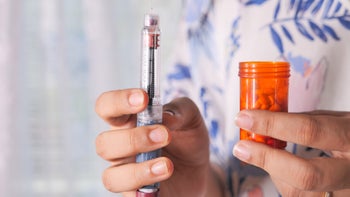
Levemir Dosages for Diabetes: Your GoodRx Guide
Key takeaways:
Levemir (insulin detemir) is a type of long-acting insulin. It’s used to improve blood glucose (sugar) levels in people with diabetes. Levemir is injected once or twice daily.
Levemir is given in combination with shorter-acting insulins for Type 1 diabetes. If you’re new to insulin, the typical starting dosage is one-third to one-half of your daily insulin requirement given as Levemir.
For Type 2 diabetes, Levemir is typically added to other diabetes medications. If you’re new to insulin, the starting dosage is usually 10 units once daily (or split into two doses).
There are ways to save on Levemir, which is only available as a brand-name medication. If you’re eligible, you could pay as little as $35 with a manufacturer copay savings card.
Access savings on related medications
Table of contents

Levemir (insulin detemir) is an injectable insulin used to treat diabetes. It’s considered a long-acting or basal insulin because its effects can last for 24 hours. You’ll typically inject Levemir once daily, but some people benefit from splitting up their dose into twice-daily injections.
If you’re prescribed Levemir, your insulin dose will be individualized to help you meet your blood glucose goals. But there are some general recommendations from the manufacturer that your healthcare provider may follow, especially as you’re getting started.
Below, we review what a typical Levemir dosage might look like, what happens if you miss your dose, and what you should do if you inject too much.
What’s the typical Levemir dosage?
If prescribed Levemir, you’ll receive it in a vial or prefilled injection pen (Levemir FlexPen). Your healthcare team will explain how to properly draw up or select your dose. You can inject Levemir in one of three places — under the skin (subcutaneously) on your stomach, thigh, or upper arm.
You’ll be instructed to inject Levemir once or twice a day. For once-daily Levemir, you’ll typically inject your dose after your evening meal or at bedtime. For twice-daily Levemir, you’ll inject the first dose in the morning, followed by the second dose 12 hours later.
Your healthcare provider will individualize your Levemir dosage. They’ll consider factors such as your blood glucose goals and readings, the type of diabetes you have, and other diabetes medications you’re taking. Keep in mind that your dosage may be adjusted over time.
Type 1 diabetes
If you’re prescribed Levemir for Type 1 diabetes, you’ll be using it in combination with shorter-acting insulins that are injected around mealtimes. Your Levemir dosage will usually depend on your total daily insulin requirement. If you’re new to insulin, this may be calculated based on your body weight.
For people with Type 1 diabetes who are new to insulin, the recommended starting Levemir dosage is one-third to one-half of your daily insulin requirement. The remainder of your daily insulin requirement will be covered by shorter-acting insulins.
Type 2 diabetes
For people living with Type 2 diabetes, Levemir is typically added to other diabetes medications. And you may be prescribed Levemir on its own or in combination with shorter-acting insulins.
The recommended starting Levemir dosage is 10 units injected once daily, or split up into two doses injected 12 hours apart. Or your starting dosage may be based on your body weight, ranging from 0.1 units per kg to 0.2 unit per kg.
Are there any dosage adjustments for drug interactions or medical conditions?
Other factors may require an adjustment to your Levemir dosage. Examples include drug interactions or certain medical conditions.
Drug interactions
If you’re living with Type 2 diabetes, you may be prescribed other blood glucose-lowering medications with Levemir. Some of these medications have a higher risk of hypoglycemia (low blood glucose), especially when combined with insulin. Sulfonylureas and meglitinides (glinides) are two examples.
When starting Levemir, or one of these medications, your healthcare provider may adjust your Levemir dosage in advance to help lower the risk of hypoglycemia. From there, your dose may be adjusted to maintain your blood glucose levels within your target range.
Kidney problems
There are no recommended Levemir dosage adjustments for people with kidney problems. However, kidney disease can increase the risk of hypoglycemia. In this case, your healthcare provider may be more cautious with your dosage to lower this risk, especially when you first start Levemir.
What happens if you miss a dose of Levemir?
If you miss a Levemir dose and only a short amount of time has passed, inject your dose as soon as you can. If you’re unsure about when to take your missed dose, or if you should skip it, reach out to your healthcare provider. Otherwise, follow their specific instructions for what to do if you miss your dose.
It’s important to inject your Levemir dose at your regularly scheduled time to get the most from treatment. If you’re frequently missing doses, using a calendar or medication reminder app can help you remember to take your medication.
What should you do if you inject too much Levemir?
Injecting too much Levemir can put you at risk forhypoglycemia, which can become life-threatening if left untreated. Dosing errors are a common culprit, so it’s important to understand how to correctly draw up or select the right dose. Double check that you’re administering the correct insulin, too.
Before starting Levemir, be sure to discuss with your healthcare team how to identify and treat hypoglycemia. Common symptoms include shakiness, hunger, and a fast heartbeat. But some people may not experience any noticeable symptoms until their blood glucose is dangerously low.
If you think you’ve injected too much Levemir, check your blood glucose levels. Levels below 70 mg/dL are considered to be hypoglycemia.
Mild hypoglycemia cases can usually be treated by following the “15-15 rule.” This involves consuming 15 g of a fast-acting carbohydrate, such as four glucose tablets, then waiting 15 minutes. Repeat this process if your blood glucose is still below 70 mg/dL.
If your blood glucose level is below 55 mg/dL, emergency medical treatment may be required. Glucagon, which helps bring up blood glucose quickly, may need to be administered. If you’ve been prescribed glucagon, make sure your friends and family know when and how to use it.
How to save on Levemir
There are ways to save on Levemir, which is only available as a brand-name product. If you’re eligible, you could pay as little as $35 for Levemir — up to three vials or two packs of Levemir FlexPens per month.
Levemir’s manufacturer also offers a patient assistance program to those who qualify. If you’re eligible, you could receive Levemir at no charge.
The bottom line
Levemir (insulin detemir) is a long-acting insulin used to treat Type 1 and Type 2 diabetes. You may be prescribed Levemir as a vial or prefilled pen (Levemir FlexPen). It’s typically injected under the skin once daily in the evening. But, sometimes the dose is split up and injected twice daily, 12 hours apart.
Your Levemir dosage will be individualized to you. But if you’re new to insulin, the manufacturer recommends certain doses when you’re first getting started. If you’re taking other diabetes medications or you have kidney problems, your dosage may be adjusted to manage your hypoglycemia risk.
Discuss any questions you have about your Levemir dosage with your healthcare provider or pharmacist.
Why trust our experts?



References
A-S Medication Solutions. (2023). Levemir- insulin detemir injection, solution [package insert].
American Diabetes Association. (n.d.). Hypoglycemia (low blood glucose).
Centers for Disease Control and Prevention. (2022). How to treat low blood sugar (hypoglycemia).
MedlinePlus. (2016). Insulin detemir (rDNA origin) injection.
Trief, P. M., et al. (2016). Incorrect insulin administration: A problem that warrants attention. Clinical Diabetes.
Was this page helpful?
Related Articles
Browse medications
View AllResearch prescriptions and over-the-counter medications from A to Z, compare drug prices, and start saving.





















